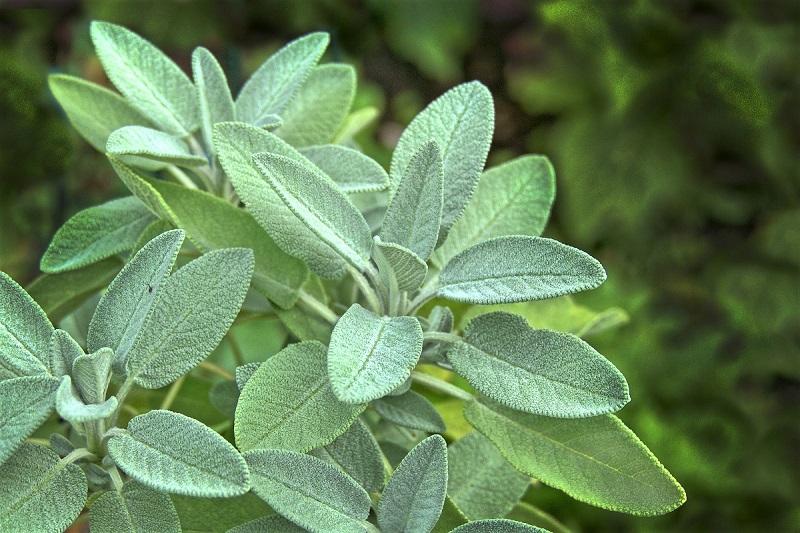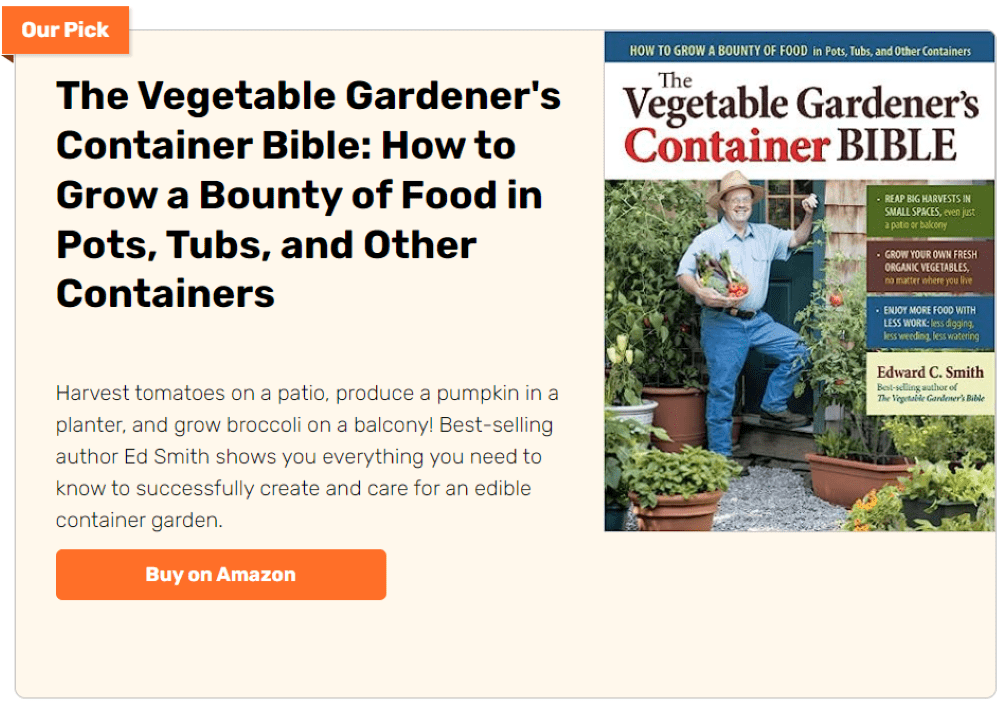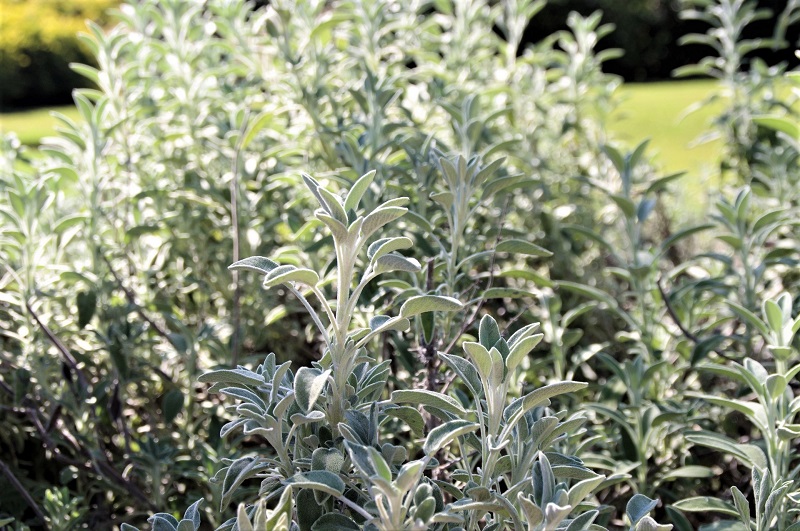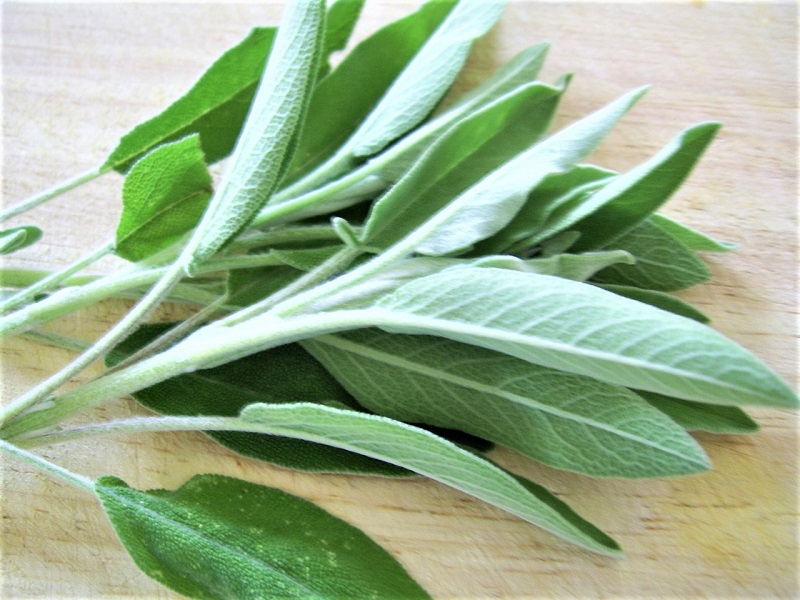
HERBS is an obvious choice for the gardening novice. They are easy to grow, require less space than vegetables, thrive in rather poor soil, and are rarely overwhelmed by pests and diseases. And of the many herbs, you can grow, few are as robust as the garden sage in a container.
Below is a simple, step-by-step guide to help you grow sage in a container.

Sage in a container is a hardy perennial with handsome, grayish-green leaves that look as good in a perennial border as they do in a pot by a window. Of the 700‐odd species of sage, many have a good flavor for cooking, but Salvia officinalis is the kitchen standard.
You can grow sage in a container so long as it receives full sun. If possible, situate the pot in an area close to the kitchen.
How to Grow Sage in a Container
Contents
The easiest way to start growing sage in a container is from a small cutting. You can purchase cuttings from your favorite garden center or you can obtain some from an established plant. Simply clip a three-inch cutting from the very tip of a stem, apply rooting hormone on the exposed portion, and plant it in either sterile sand or vermiculite. Roots should emerge within six weeks.
Preparing the Container
Before choosing a container, you must first decide how much sage in a containeryou want to grow. Sage plants usually grow two feet high and need a foot of space in between. Choose containers that will accommodate your plant or plants without crowding. The vessel should permit sufficient room for roots and have at least one good-sized drainage hole in the bottom. Experts recommend clay pots for growing sage.
Once you have decided on a container, wash it with mild soap and water and allow it to dry. If you want to use an old container, make sure it is clean. Wash away any residual dirt with mild soap, water, and a brush. Rinse and allow to dry under the sun. Then spray the inside and rim with a simple mixture of seven parts water to one-part bleach. Allow the container to dry before moving on to the next step.

Planting Sage in a Container
You can use store-bought or homemade potting soil for a growing medium as long as it is clean and sterile. Use a mixture that contains nutrient material to feed your plant. The mix should also provide good drainage and aeration. You may choose a medium that is specially made to hold vegetables. Otherwise, use container compost to augment the potting soil. Fill the container with the soil to within 1½ to 2 inches of the rim.
Dig a hole in the potting mix large enough to accommodate the roots of your young sage plant. Place the plant in the hole. Hold it up so that the bottom of the plant is even with the top of the soil. Make sure the roots hang down. No part of the roots should bend at the bottom. Fill the hole with the potting soil and tamp down to firm and settle the plant in place.
Water the newly planted sage in a container thoroughly and deeply. Allow the water to run out the bottom of the container. Water again once the soil is completely dry.

Care and Maintenance
If you live in a hot, dry area, water your plant more frequently in the summer. Feed your sage in a container with a good liquid or granular fertilizer twice during the growing season. Pinch off any flowers to promote fuller, bushier growth. The more leaves your plant produces, the more abundant your sage harvest.
Sage needs six to eight hours of full sun daily. If your sunny window does not provide this much daily sun, you use fluorescent lighting. Experts recommend a double fluorescent tube mounted under a countertop. You can sit the potted herb 5 inches from the light, but no farther away than 15 inches.

Pruning and Humidity
Indoors, you will need to keep the plants in a warm area, away from drafts. The ideal growing temperature is around 21°C. You will need to provide the plant with enough humidity, as well. You can do this with a nearby pebble tray or humidifier. If you intend to rely solely on artificial light to grow sage, then you should allow the plants 14 to 16 hours of light a day.
Sage requires hard pruning once a year. The best time to do this is when new growth starts to appear. Young leaves and new buds usually form in the spring. Trim all the dead, decaying, and crossing woody stems. You can do another, less aggressive pruning after flowering ends in the summer.

Harvesting Sage
You can harvest sage leaves whenever you need some for cooking, clipping just above the spot where two leaves meet. For the richest concentration of aromatic oils, harvest the leaves in the morning. Keep in mind that sage tends to become woody and its growth starts to decline after a while. That’s why experienced gardeners recommended that you replace your plant every four years or so.
Growing Sage in a Container: A Versatile Gardening Choice
Gardening in containers offers numerous benefits, especially when growing herbs like sage. This approach allows gardeners to optimize growing conditions and enjoy fresh herbs, even in limited spaces. Sage, with its aromatic leaves and easy-to-grow nature, thrives in containers, making it an ideal choice for both experienced and novice gardeners.
Space Efficiency
Maximizing Limited Spaces
Container gardening, particularly growing sage, is a boon for those with restricted gardening areas. The compact nature of containers allows them to fit into small spaces like apartment balconies, compact patios, or even on windowsills. This means fresh sage is accessible, even in the most space-constrained environments.
Urban Gardening Solution
For urban residents, growing sage in containers is a practical solution. In cities where garden space is a luxury, containers allow cultivating herbs without needing a traditional garden. This approach brings a touch of greenery to urban settings, enhancing the living space with aesthetic and practical benefits.
Customizable for Any Setting
Containers come in various sizes and styles, making them adaptable to different spaces and decor. You can choose containers that suit sage’s growth requirements and complement your living area’s aesthetic. This customization adds a personal touch to your gardening experience, blending seamlessly with your home environment.
Accessibility and Convenience
Sage in a container at arm’s reach encourages its use in daily cooking. Sniping a few leaves from a balcony or windowsill container is far more convenient than trek out to a distant garden plot. This accessibility makes cooking more enjoyable and ensures you’re using the freshest herbs possible.
Soil and Growth Control
Optimal Soil Conditions
Growing sage in containers gives you the unique advantage of creating the perfect soil environment. Sage prefers well-drained, loamy soil, which is easy to achieve in a container setting. By mixing your soil, you can ensure the right balance of nutrients, drainage, and aeration. This tailored approach leads to healthier plants and more robust growth.
Prevention of Soil-Borne Diseases
In traditional garden settings, plants are more susceptible to soil-borne diseases. However, container gardening significantly reduces this risk. Using a sterilized potting mix can prevent common garden afflictions like root rot and fungal infections. This control keeps your sage healthier and more productive.
Adjustments Based on Observations
Container gardening allows for close monitoring and quick adjustments to the soil. You can easily change the soil composition if your sage is not thriving. This could involve adjusting pH levels, adding more organic matter, or improving drainage. Such flexibility is not as easily achievable in open garden soils.
Long-Term Soil Health
Over time, soil in open gardens can become depleted or compacted, affecting plant health. In containers, you can regularly refresh the soil, ensuring your sage has access to essential nutrients. This ongoing soil management is key to maintaining a healthy sage plant.
Flexibility and Convenience
Adaptable Sunlight Exposure
Growing sage in a container offers remarkable flexibility in managing sunlight exposure. You can easily shift the container to ensure your sage gets the ideal amount of sunlight throughout the day. This adaptability is especially beneficial for sage in a container, as it requires consistent sun exposure for optimal growth.
Protection from Extreme Weather
The convenience of growing sage in a container becomes evident when dealing with extreme weather. You can quickly move the container with sage indoors or to a sheltered spot, safeguarding your sage in a container from damaging elements like frost, heavy rain, or intense heat.
Controlled Growing Environment
When growing sage in a container, you gain significant control over the growing conditions. This control is crucial for sage in a container, as you can adjust factors like humidity and temperature to suit the needs of sage. The ability to modify the environment around your sage in a container ensures a healthier and more robust plant.
Ease of Rotation and Pruning
Maintaining sage in a container is easier due to the mobility of the container. Whether it’s rotating the sage in a container for uniform growth or pruning, the container’s portability makes these tasks simpler. This ease of maintenance is a key benefit when growing sage in a container, ensuring your plant not only thrives but also looks great.
In summary, the flexibility and convenience of growing sage in a container are unmatched. The ability to control sunlight exposure, protect sage in a container from extreme weather, manage the growing environment, and maintain the sage in a container with ease are all compelling reasons to choose container gardening for your sage.
Watering and Feeding Sage Plants in Containers
Proper watering and feeding are crucial for the health and growth of sage in a container. Understanding the specific needs of sage in a container helps develop a routine that ensures your plant thrives.
Watering Sage in a Container
Sage in a container requires careful watering to prevent both over and under-watering. Sage prefers slightly dry conditions, so it’s important to let the soil in the container dry out slightly between waterings.
Check the soil moisture by inserting your finger an inch into the soil. If it feels dry, it’s time to water your sage in a container. Always water deeply until excess water drains out of the bottom of the container. This ensures that the roots of sage in the container receive adequate moisture.
Feeding Sage in a Container
Feeding is another critical aspect of caring for sage in a container. Use a balanced, water-soluble fertilizer every 4-6 weeks during the growing season. This will provide the necessary nutrients for your sage in a container to flourish. Be cautious not to over-fertilize, as this can lead to excessive leaf growth at the expense of the rich flavor sage is known for.
Monitoring Plant Health
Regularly observe your sage in a container for signs of nutrient deficiency or watering issues. Yellowing leaves or stunted growth can indicate that your sage in a container needs more nutrients or a better watering routine. Adjust your care practices accordingly to maintain a healthy sage plant.
In conclusion, the right balance of watering and feeding is key to growing a healthy sage in a container. By monitoring soil moisture and providing regular feedings, you can ensure your sage in a container grows lush and flavorful, perfect for culinary use.
Pests and Diseases Affecting Sage in Containers
Growing sage in containers can sometimes lead to pest and disease challenges. Being aware of these issues and knowing how to address them is key to maintaining a healthy sage plant.
Common Pests
Identifying and Managing Aphids
Aphids are small, soft-bodied insects that can be green, black, brown, or pink. They cluster on the undersides of sage leaves, feeding on the plant’s sap. This not only weakens the sage but can also lead to distorted growth and a sticky residue known as honeydew, which can attract other pests. Regularly check your sage in a container for aphids. If present, you can often dislodge them with a strong jet of water. For more persistent infestations, apply a mild soap solution or neem oil to the affected areas.
Combating Spider Mites
Spider mites are tiny, spider-like pests, often red or brown. They thrive in hot, dry conditions and can quickly cause significant damage to sage in containers. They leave fine webs on the plant and cause the leaves to look speckled and wilted. Increasing humidity around your sage can deter spider mites. If they are present, rinse the leaves with water or use an appropriate miticide.
Dealing with Whiteflies
Whiteflies resemble tiny white moths and are often found on the undersides of leaves. They suck sap from the sage, causing yellowing and weakening of the plant. Whiteflies can be tricky to control once they establish a presence. Yellow sticky traps can be effective in catching adult whiteflies. For controlling larger infestations, insecticidal soaps or neem oil can be applied to the sage in a container.
Preventative Measures
Prevention is key in managing pests on sage in containers. Ensure your plant is healthy and stress-free, as stressed plants are more susceptible to pest infestations. Proper watering, feeding, and positioning your sage in a container with good air circulation can help keep it healthy and less attractive to pests.
Disease Prevention
Understanding Powdery Mildew
Powdery mildew is a common fungal disease that appears as a white, powdery coating on sage leaves. It often occurs in humid conditions with poor air circulation. To prevent this, place your sage in a container where it can receive good airflow.
If powdery mildew appears, remove affected leaves immediately. Increasing sun exposure can also help, as the fungus prefers shaded, damp environments. Applying an organic fungicide specifically designed for powdery mildew can be effective for severe cases.
Combatting Root Rot
Root rot is another issue affecting container sage, usually due to overwatering or poor drainage. This disease causes the roots to decay, impairing the plant’s ability to absorb nutrients. Ensure your container has adequate drainage holes and use well-draining potting mix. Water only when the top inch of soil feels dry to the touch. If root rot is suspected, remove the plant from the container, trim away the rotted roots, and replant it in fresh, well-draining soil.
Preventative Cultural Practices
Preventing diseases in sage starts with good cultural practices. Choose a container that allows room for growth, as overcrowding can lead to moisture retention and reduced air circulation. Regularly clean your containers and tools to avoid the spread of pathogens. Also, occasionally rotate your sage’s position in a container to ensure all sides receive equal light and air exposure.
Monitoring for Early Signs of Disease
Regularly inspecting your sage in a container is vital for early disease detection. Look for discolored leaves, stunted growth, or unusual leaf spots. Early detection means you can swiftly mitigate the problem, often saving the plant from more serious damage.
Conclusion
Growing sage in a container offers a rewarding gardening experience. It provides flexibility in plant care, space efficiency, and soil and growth conditions control. You can maintain a healthy sage plant by understanding and addressing common pests and diseases. Regular monitoring, proper watering, feeding, and preventative practices ensure your sage thrives.
For more growing guide, check out our post on growing rosemary in containers!








